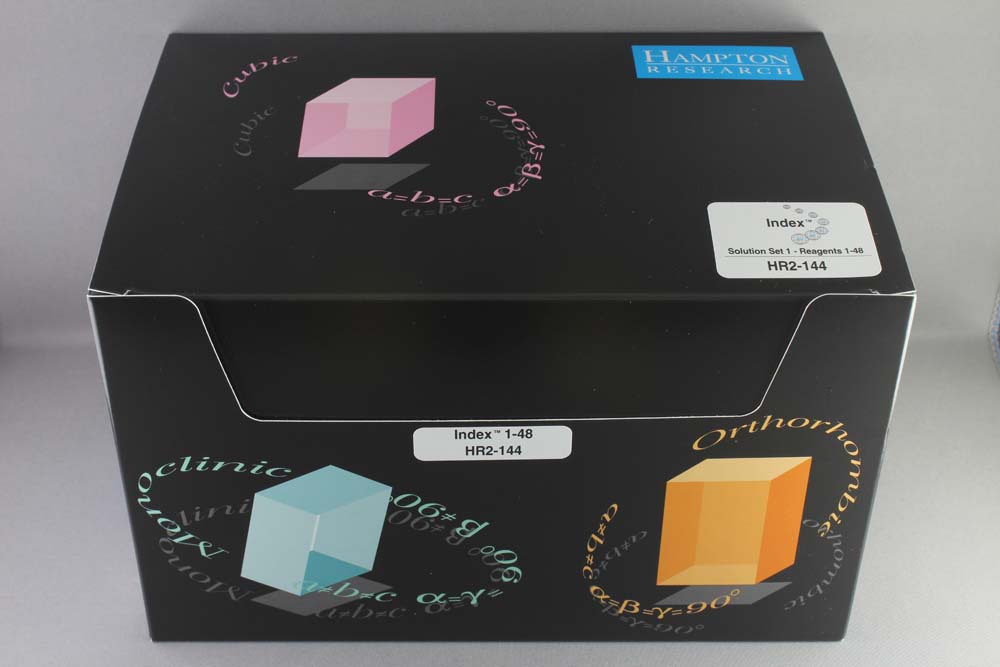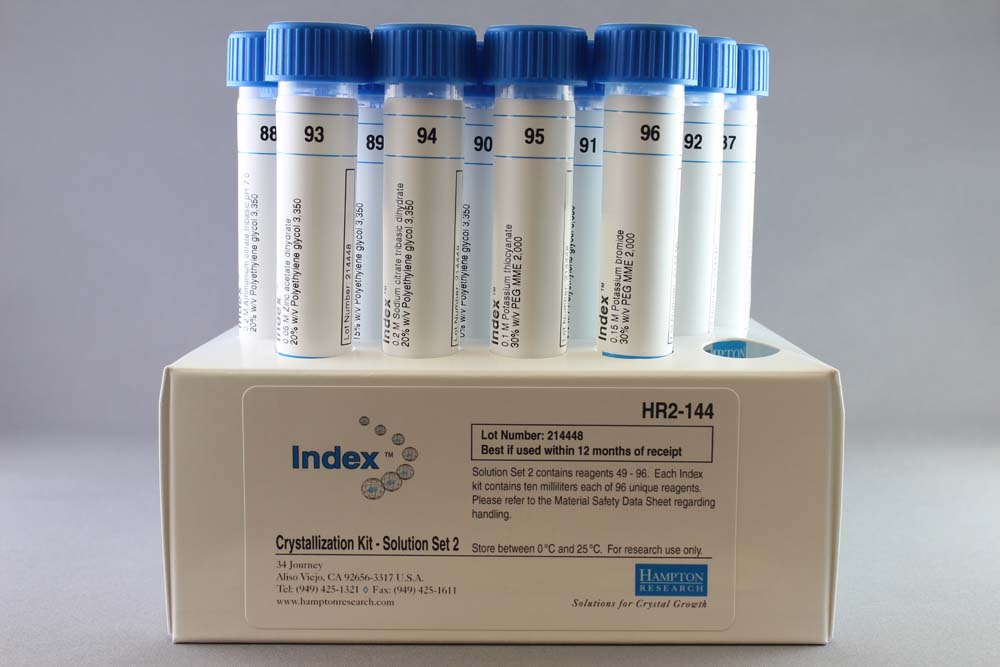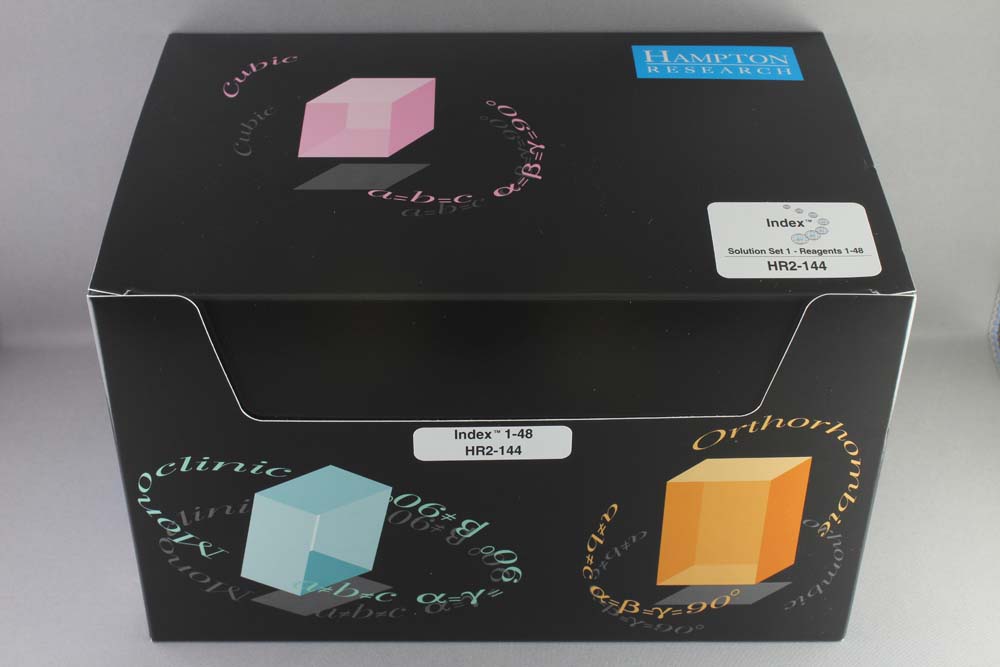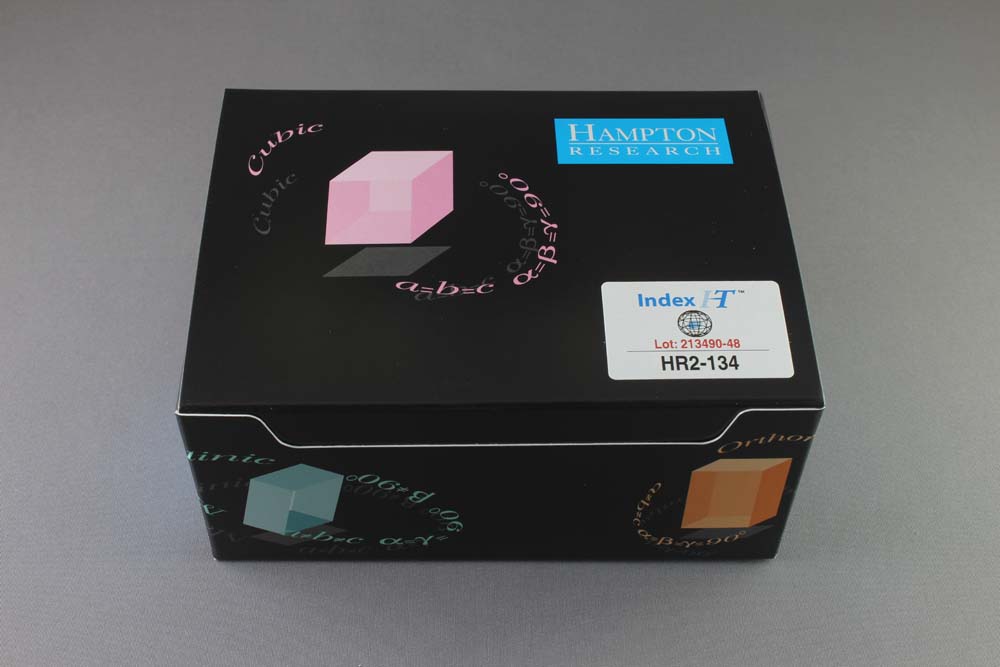Hampton Research蛋白结晶试剂盒






Products > Crystallization Screens > Index > Index • Index HT
Index • Index HT
Applications
- Primary, diverse reagent system crystallization screen for proteins, complexes, peptides, nucleic acids, & water soluble small molecules
Features
- Developed at Hampton Research
- A data-driven biased sparse matrix and grid screen
- Screens classic, contemporary, & modern crystallization reagents
- Samples pH 3 to 9
- Compatible with microbatch, vapor diffusion, & liquid diffusion methods
- Specially formulated reagent zones:
- Traditional salts versus pH
- Neutralized organic acids
- High [salt] with low [polymer]
- High [polymer] with low [salt]
- Low ionic strength versus pH
- PEG & Salt versus pH
- PEG & Salt
- Tube or Deep Well block format
Description
Index is designed as a 96 reagent crystallization screen that combines the strategies of the grid, sparse matrix, and incomplete factorial screening with traditional, contemporary, and new crystallization reagent systems into a highly effective and efficient format.
Index, as the name implies, efficiently samples a series of specially formulated reagent zones to identify which reagent class or classes and pH are effective in producing crystals or limiting sample solubility. Results from Index can be used to design optimization experiments and to identify follow on screens by reagent class. For example, positive results with salt based reagents in Index may be followed up with further screening using SaltRx or Grid Screen Salt HT. Success with polymer based reagents in Index may be followed up with further screening using PEGRx or PEG/Ion.
Index utilizes a broad, yet refined portfolio of crystallization reagent systems. These include the following: (1) traditional salts such as Ammonium sulfate and Sodium chloride versus pH; (2) neutralized organic acids such as Sodium malonate and Tacsimate; (3) High salt concentration mixed with low polymer concentration as well as high polymer concentration mixed with low salt concentration and; (4) Low ionic strength using polymers such as PEG, MPD, Pentaerythritols versus pH. These reagent systems are formulated across a sparse matrix and incomplete factorial of concentration ranges, sampling a pH range of 3 to 9.
Index contains 96 unique reagents, 10 ml each.
Index HT contains 96 unique reagents in a single Deep Well block format.
Ready-to-use reagents are sterile filtered and formulated with ultra-pure Type 1 water, using the highest purity salts, polymers, organics and buffers. Individual reagents are available through the Hampton Research Custom Shop.
Measured pH range of kit is 3 to 9 at 25°C
Average measured pH of kit is 6.8 at 25°C
Median measured pH of kit is 6.9 at 25°C

Click to Zoom In
CAT NO
HR2-144
NAME
DESCRIPTION
10 ml, tube format
PRICE
$504.00
cart quote
CAT NO
HR2-134
NAME
DESCRIPTION
1 ml, Deep Well block format
PRICE
$147.00
cart quote
Support Material(s)
 HR2-144 Index Documents
HR2-144 Index Documents HR2-144 Index SDS
HR2-144 Index SDS HR2-134 Index HT Documents
HR2-134 Index HT Documents HR2-134 Index HT SDS
HR2-134 Index HT SDS Index & Index HT Formulations & Scoring
Index & Index HT Formulations & Scoring Related Item(S)
- Individual Index • Index HT Reagents
References
1. The advantages of using a modified microbatch method for rapid screening of protein crystallization conditions. A. D′Arcy, A. Mac Sweeney, M. Stihle and A. Haber. Acta Cryst. (2003). D59, 396-399.
2. Cloning, expression, purification, crystallization and preliminary X-ray diffraction analysis of propionate kinase (TdcD) from Salmonella typhimurium. D. K. Simanshu and M. R. N. Murthy. Acta Cryst. (2005). F61, 52-55.
3. Preparation, crystallization and preliminary X-ray analysis of the methionine synthase (MetE) from Streptococcus mutans. T.-M. Fu, X.-Y. Zhang, L.-F. Li, Y.-H. Liang and X.-D. Su. Acta Cryst. (2006). F62, 984-985.
4. Crystallization and preliminary X-ray analysis of glutathione transferases from cyanobacteria. S. C. Feil, J. Tang, G. Hansen, M. A. Gorman, E. Wiktelius, G. Stenberg and M. W. Parker. Acta Cryst. (2009). F65, 475-477.


Hampton Research, first in crystallization since 1991, developing and delivering crystallization and optimization screens, reagents, plates, and other tools for the crystallization of biological macromolecules, including proteins (antibody), peptides (insulin), and nucleic acids (DNA).
- Products
- Gallery
- My Account
|
|
|
- Contact Us
- Quick Order
- Support
|
- Privacy Policy
- Terms and Conditions
|
- Products
- Gallery
- My Account
- Support
- Contact Us
- Quick Order
- Privacy Policy
- Terms and Conditions
|
|
|
|
|
|
|
© 2021 HAMPTON RESEARCH CORP.
| Website by Skyhound Internet
















